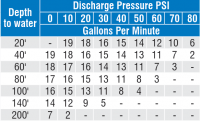Victoria-nola
New Member
Hi, new here, home/farm owner with many projects to do. We are aspiring market gardeners, would like to do a small goat dairy, but for this summer we're setting up a 1/4 acre field of watermelons as they do well in our area and there is a market for local melons. For the moment what we need is to start using the well that's here, it's 60 years old or more with a thick ceramic casing in very good condition, about 6" inner diameter, top of casing is ~30-in above ground level. Well is on high point of gently sloping property along with house and barn. We want to use the well to irrigate our garden and fields. Water looks and smells great but have not had it tested yet. We need to keep our expenses very low. If anyone can help me with my questions I would be very grateful.
The static water level is 10-ft below top of casing, bottom of well is 20-ft below top of casing. Do not yet know flow rate. We have been informed that it's not possible to really test for flow rate with a hand pump. Also need to pump out standing water in order to get a fresh sample for testing. So even though I do want both a hand pump and an electric, it seems that we need to start with electric.
Thinking to use an external shallow-well jet pump with integrated pressurized tank, such as http://www.harborfreight.com/1-hp-s...th-pressure-control-switch-950-gph-63407.html Or, what would be a good idea if this type is not a good choice? What we want to do is run drip irrigation in sections, which would be set up according to what our flow rate/pump rate can handle. I have a bunch of questions but my first is, would the 5-gal tank model be capable of running drip irrigation for periods of time, or should we plan to fill a reservoir and gravity feed (or possibly have to attach another pump) for drip irrigation? We already have several food-safe 55-gal light-blue barrels that we could connect in series to create a reservoir.
Another set of questions has to do with setup. First, since I know I want to add a hand-pump (cheap one such as https://www.amazon.com/Simmons-1160...8&qid=1486704949&sr=8-1&keywords=pitcher+pump) in the future, it seems possible to install said hand-pump by going through the same well cap as the jet pump (http://www.tractorsupply.com/tsc/pr...well-seal-6-in-x-1-1-4-in-x-1-in?cm_vc=-10005) If so, that's what I'd want to buy to start with. And if so, what would that installation altogether look like? Can the hand pump still sit directly on top of the seal, with the electric pump installed very nearby? Or would we need to offset the hand pump as well? I wouldn't mind if the whole thing could be made to look charming as well, but I guess that's another issue.
I saw where some well threads here mentioned poly pipe for use with pumps and I am very interested in that, not being a fan of pvc/solvents. Is this the stuff? http://www.tractorsupply.com/tsc/pr...flexible-coil-pipe-1-in-x-100-ft?cm_vc=-10005
Thank you for any thoughts.
The static water level is 10-ft below top of casing, bottom of well is 20-ft below top of casing. Do not yet know flow rate. We have been informed that it's not possible to really test for flow rate with a hand pump. Also need to pump out standing water in order to get a fresh sample for testing. So even though I do want both a hand pump and an electric, it seems that we need to start with electric.
Thinking to use an external shallow-well jet pump with integrated pressurized tank, such as http://www.harborfreight.com/1-hp-s...th-pressure-control-switch-950-gph-63407.html Or, what would be a good idea if this type is not a good choice? What we want to do is run drip irrigation in sections, which would be set up according to what our flow rate/pump rate can handle. I have a bunch of questions but my first is, would the 5-gal tank model be capable of running drip irrigation for periods of time, or should we plan to fill a reservoir and gravity feed (or possibly have to attach another pump) for drip irrigation? We already have several food-safe 55-gal light-blue barrels that we could connect in series to create a reservoir.
Another set of questions has to do with setup. First, since I know I want to add a hand-pump (cheap one such as https://www.amazon.com/Simmons-1160...8&qid=1486704949&sr=8-1&keywords=pitcher+pump) in the future, it seems possible to install said hand-pump by going through the same well cap as the jet pump (http://www.tractorsupply.com/tsc/pr...well-seal-6-in-x-1-1-4-in-x-1-in?cm_vc=-10005) If so, that's what I'd want to buy to start with. And if so, what would that installation altogether look like? Can the hand pump still sit directly on top of the seal, with the electric pump installed very nearby? Or would we need to offset the hand pump as well? I wouldn't mind if the whole thing could be made to look charming as well, but I guess that's another issue.
I saw where some well threads here mentioned poly pipe for use with pumps and I am very interested in that, not being a fan of pvc/solvents. Is this the stuff? http://www.tractorsupply.com/tsc/pr...flexible-coil-pipe-1-in-x-100-ft?cm_vc=-10005
Thank you for any thoughts.


